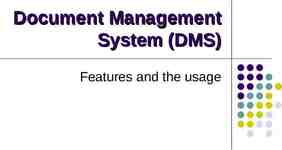Managing today’s weatherization program session overview
57 Slides1.72 MB

Managing today’s weatherization program session overview Challenges Concepts A little theory Case study A couple tools Food for thought

Managing Today’s Weatherization Program

bpc.oppco.org

Dave Finet Opportunity Council Director, Energy & Home Repair 20 years at the OC Started as a crew member Worked as auditor Production coordinator Program manager Service area director ( 12 years) Made just about every mistake possible

Opportunity Council Private non-profit community action program Bellingham Washington Serving a 3 county area The agency just celebrated its 40 year anniversary

Opportunity Council Programs Early Childhood Opportunities Northwest Childcare and Family Resources Community Services Island County Services Energy & Home Repair Services

Energy & Home Repair Programs Energy Assistance (LIHEAP/PSE) Weatherization Home rehabilitation / repair program Indoor environmental programs Building Performance Center 30 employees 3 office locations 4.6 million budget 150 weatherization projects 75 home rehab projects Fee for service

Funding Allocated Dept. of Energy LIHEAP Bonneville Power Administration Puget Sound Energy Energy Matchmakers Washington Community Energy Fund HOME Competitive CDBG USDA 2060 HUD Lead hazard control

Building Performance Center Training – Peer Circuit Rider – Weatherization agencies – Systems analysis – Contractors – Utilities Building Performance – – – – Indoor air Energy retrofits Building failures Low-income weatherization – Consulting, design – Energy Star

Opportunity Council Energy & Home Reapir Dave Finet Director Jon Martin Development Manager Vicki Lippiatt Fiscal Coordinator Gail McDonald .5 Admin Asst. Chris Clay Techncial Coordinator QA Tamara Rollins Rehab Intake Mark Wickman Lead Technician Fred Kunchick Tech I John Davies WX & Rehab Program Manager Kyle White Production Manager Tom Brenton Lead Techncian Klayton Williams Tech I Tom Bunger Island Co WX and Home Rehab Coordinator Bob Gronhovd Lead Technician OPEN Tech I Jim Hendrick Tech I Dan Ceasar WX Auditor Lead Tech Adam Popa Tech II Debbie Patton Energy Assistance Prog Manager OpenPosition Project Coordinator Daniel Hooper Project Coordinator Paul Reavley Project Coordinator IT Lead Sean Slocum HQS Specialist Claudia Basso Energy Lead Toby Martinez Energy Specialist Polly Criscoula Energy Specialist Kristan Johnson Outreach Coordinator Lorena Weisenberger Outreach lead

No Orphans A case study in systems thinking and program revitalization Unhappy clients Marginal workmanship Not meeting production goals (closure) Bickering staff, finger pointing 100 open projects Vendors not getting paid No one taking responsibility

Weatherization program Descriptors “Messy” “Tough” “Complicated” “Challenging” “Endless change”

Technical developments of the weatherization program House as a system Blower door diagnostics Combustion safety testing Computerized audit tools Ventilation Lead Based Paint Mold Worker safety

Training and technical assistance investment Over the last 15 years there has been a lot of technical and field training but not much training or technical assistance for management.

Where has management come from? The ranks Other social service programs Private sector Are new managers (leaders) prepared to lead programs as complicated as weatherization?

Group exercise Introduce yourself to the person next to you (groups of 2 or 3) Where are you from? How is your job related to weatherization management? From your perspective what is the biggest challenge in managing weatherization programs? 10 minutes

Challenges of management Limited financial resources Changing regulations Employee Compensation Training Retention Development of contractor relationships Budget development and tracking Insurance Risk management Diversity of funding sources Working within a larger agency

Keys to successfully managing today’s weatherization program Leadership from management Build a team Understanding the work Developing key staff Create an enjoyable work environment Supportive personnel practices Tracking progress at the program level Emphasis on quality and customer satisfaction

Leadership by definition lead·er·ship n 1. the office or position of the head of a political party or other body of people 2. the ability to guide, direct, or influence people 3. guidance or direction 4. a group of leaders (takes a singular or plural verb)

Leadership Creating shared vision Guidance Clear expectations Role and responsibility Planning Long term Short term Manpower planning Implementation Appropriate delegation Creating shared vision

Building a Team Part of being a team is being able to trust and rely on your teammates. Once that trust is broken you cease to be a team, each team member walking through the motions of their own responsibility without taking advantage of the efforts and talents of the others.

Leading a team Successful leadership is maximizing the talent and resources available within the team to meet common goals that align with the teams values and vision.

Shared vision Sustainable organizations rely on leadership that can create systems and lines of communication that allow for the continual adjustment of course to achieve established goals created by the the team out of shared vision. What is the difference between Conversation and Dialogue?

Shared vision is created through conversation 1. 2. 3. 4. 5. con·ver·sa·tion n an informal talk with somebody, especially about opinions, ideas, feelings, or everyday matters the activity of talking to somebody informally an informal talk about something involving representatives from various interested groups an interaction with a computer carried on in real time a nonverbal exchange that is perceived to have the qualities of conversation di·a·logue or di·a·log n 1. the words spoken by characters in a book, a film, or a play, or a section of a work that contains spoken words 2. a formal discussion or negotiation, especially between opposing sides in a political or international context

Role responsibility defined role or rôle n 1. an individual part in a play, movie, opera, or other performance played by an actor, singer, or other performer 2. the usual or expected function of somebody or something, or the part somebody or something plays in a particular action or event 3. the part played by somebody in a given social context, with any characteristic or expected pattern of behavior that it entails

Implementation the responsibility of Management The single biggest barrier to program development or success is the lack of effective implementation. Why is it so difficult? 5 Minutes

Implement - defined 1. to put something into effect or action 2. to provide or equip somebody with the tools or other means to do something (formal)

Understanding the work Get into the field Observe staff in action Contact with clients Review projects with staff Knowledge of program policies and specifications

Developing key staff Emphasis on learning Meaningful evaluation Involve them in planning Provide them with the information they need to make decisions Give them the authority equal to the responsibility Utilize and further develop their strengths Get to know them, find out what gets them excited

Key Your No.2 is your most important hire. Pick one who complements your management style, shows loyalty without being a yes-man, and has a talent for working with others. Shackleton John Davies Weatherization & Home Repair Manager

Create an enjoyable work environment Surround yourself with cheerful, optimistic people. They will reward you with the loyalty and camaraderie vital for success. Do your part to help create an upbeat environment at work. A positive and cheerful workplace is important to productivity.

Personnel management Good hiring practices (hire based on values and then experience) Compensation Evaluation Professional development Mentoring Creating the culture

Shackleton’s Way on hiring Be a creative, unconventional interviewer if you seek creative, unconventional people. Go deeper than job experience and expertise. Ask questions that reveal a candidate’s personality, values, and perspective on work and life. Hire those who share your vision. Someone who clashes with your personality or the corporate culture will hinder your work.

Supporting staff To help your staff do top-notch work, give them the best equipment you can afford. Working with outdated, unreliable tools creates an unnecessary burden. Always keep the door open to your staff members, and be generous with information that affects them. Well-informed employees are more eager and better prepared to participate. Shackleton

Tracking progress at the program level Don’t depend on grant/fund accounting to run your business Provide staff with reports that make sense to them Meet with staff and review the progress Take the time to analyze the data

Emphasis on quality Make your standards clear Identify quality when you see it, praise it Perform in-progress inspections Involve staff in problem resolving quality issues Create feedback loops

The Art and Practice of the Learning Organization Systems thinking Personal mastery Mental models Building shared vision Team learning Peter Senge, The Fifth Discipline

No Orphans A case study in systems thinking and program revitalization Unhappy clients Marginal workmanship Not meeting production goals (closure) Bickering staff, finger pointing 100 open projects Vendors not getting paid No one taking responsibility

Orphan, defined or·phan n 1. a child whose parents are both dead or who has been abandoned by his or her parents, especially a child not adopted by another family 2. a young animal whose mother is dead or has abandoned it 3. an opening line of a paragraph that is also the last line on a page, cut off from the rest of the paragraph by the page break. 4. what the Opportunity Council was doing to it’s client because they didn’t have systems of accountability

(Problem) on the surface To many open projects – (No established goal for project completions) Lots of calls from unhappy clients in progress – (Gaps in quality assurance, incomplete system) Middle management always asking for more staff – (No routine review of production goals, unclear expectations) To many trips out to each household – (Lack of mentoring and monitoring by the director) Development of program came to a halt – (Systems were not thought out well enough in advance to implement new technology or new programs)

(Problem) on the surface Vendors not getting paid – (A parent agency problem that exacerbated the other problems) No one taking responsibility, people problem – (Unclear roles and responsibilities)

Continuity Everyone was running their own program – – – – No shared vision Little accountability Lack of discipline Roles and responsibilities not clear

Power of many? or the thoughts of a few? As a leader I wasn’t utilizing the biggest asset I had, the power of group thinking. It was my responsibility to get things fixed. I didn’t want to go through this again.

Nice guy or leader? Do you have to choose? Establish order and routine on the job so all workers know where they stand and what is expected of them. The discipline makes the staff feel they’re in capable hands. Always keep the door open to your staff members, and be generous with information that affects them. Well-informed employees are more eager and better prepared to participate.

Solutions through systems thinking Document individual roles and responsibilities Consolidate contacts with clients (project coordinators and lead technicians) Develop a timeline for expected project closure Establish annual and monthly production goals, review monthly Meet monthly and review every “open” project as a group Track program expenses at the program level, “real time accounting”

Communication loops Monthly Safety meetings Technician roundtable mtg. Project Coordinators/Inspectors mtg. Weatherization & rehab No Orphans Emergency furnace repair No Orphans Building Performance Center No Orphans

Communication loops Quarterly Energy & Home Repair Management Team mtg. Every other month Energy & Home Repair all staff mtg. Annual All day retreat with families

Opportunity Council Energy & Home Reapir Dave Finet Director Jon Martin Development Manager Vicki Lippiatt Fiscal Coordinator Gail McDonald .5 Admin Asst. Chris Clay Techncial Coordinator QA Tamara Rollins Rehab Intake Mark Wickman Lead Technician Fred Kunchick Tech I John Davies WX & Rehab Program Manager Kyle White Production Manager Tom Brenton Lead Techncian Klayton Williams Tech I Tom Bunger Island Co WX and Home Rehab Coordinator Bob Gronhovd Lead Technician OPEN Tech I Jim Hendrick Tech I Dan Ceasar WX Auditor Lead Tech Adam Popa Tech II Debbie Patton Energy Assistance Prog Manager OpenPosition Project Coordinator Daniel Hooper Project Coordinator Paul Reavley Project Coordinator IT Lead Sean Slocum HQS Specialist Claudia Basso Energy Lead Toby Martinez Energy Specialist Polly Criscoula Energy Specialist Kristan Johnson Outreach Coordinator Lorena Weisenberger Outreach lead

Staffing rules of thumb Managers should supervise no more than 6 supervisors Construct a progressive skill set for staff to achieve, so staff are ready for promotion Hire from within whenever possible Don’t put staff in positions they are not ready for Schedule regular meetings, don’t cancel

Quality Assurance Separate quality assurance and production Quality assurance staff are responsible for training Their role is to not only identify quality issues but to work with staff and management to resolve them.

Roles and Responsibilities Objective: キ To communicate the team philosophy of Energy and Home Repair Services Management. キ Clarify roles and responsibilities of team members. キ Build a common vision of how we need to work together and interact to effectively deliver our services and meet our goals.

Project Coordin ators 1) Develop a well thought out project plan that meets the cli ents needs,achievable by the crewsand reasonably within our funding parameters 2) Communicate the project plan to the leadtech prior to the start of the project. 3) Identify potential obstacleswith the project, major repairs, leadissuesect. 4) Coordinate subcontractors so they don’t interferewith crew progress. 5) Check in daily with the leadtech on the progressof the project, seewhat you can do to help. 6) Soli cit input on the project plan from the leadand QA, be thick skinned. 7) Be part of the job, support your leadtech, they may be out sick tomorrow, have you kept up on the progressof the job well enough to support the techs that backup the lead? 8) Check in on-site at your projects with the leadwhen thereare contentious or compli cated issuesor diffi cult processes. 9) Pre order any specialty items and check with the person doing inventory and purchasing to makesurethe necessar y materials arein stock. 10) Have an expectation you wil l receive training and technical assistance, from quali ty assura nce, project coordinators and the program manager. 1) Communicate your needsto the program manager.

Tools Spreadsheets that track monthly progress, both financial and individual production Establish a rate Standardize and consolidate forms

Planning Agency strategic plan Energy & Home Repair strategic plan Annual production plan Annual staff plan Individual staff plans Budget development

Program accountability Every program should be able to answer . How many units will you do this year? How many units will you do this month? What is your average cost per unit? How many utility do you average per unit? What is your program goal or timeline for completing a project? If you have crews, on average how many days does it take to complete a unit?

Dave Finet dave [email protected]

bpc.oppco.org






